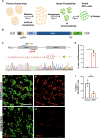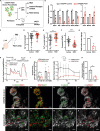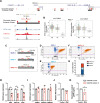CRISPR-based genome editing in primary human pancreatic islet cells
- PMID: 33893274
- PMCID: PMC8065166
- DOI: 10.1038/s41467-021-22651-w
CRISPR-based genome editing in primary human pancreatic islet cells
Abstract
Gene targeting studies in primary human islets could advance our understanding of mechanisms driving diabetes pathogenesis. Here, we demonstrate successful genome editing in primary human islets using clustered regularly interspaced short palindromic repeats (CRISPR) and CRISPR-associated protein 9 (Cas9). CRISPR-based targeting efficiently mutated protein-coding exons, resulting in acute loss of islet β-cell regulators, like the transcription factor PDX1 and the KATP channel subunit KIR6.2, accompanied by impaired β-cell regulation and function. CRISPR targeting of non-coding DNA harboring type 2 diabetes (T2D) risk variants revealed changes in ABCC8, SIX2 and SIX3 expression, and impaired β-cell function, thereby linking regulatory elements in these target genes to T2D genetic susceptibility. Advances here establish a paradigm for genetic studies in human islet cells, and reveal regulatory and genetic mechanisms linking non-coding variants to human diabetes risk.
Conflict of interest statement
The authors declare no competing interests.
Figures






Similar articles
-
SIX2 and SIX3 coordinately regulate functional maturity and fate of human pancreatic β cells.Genes Dev. 2021 Feb 1;35(3-4):234-249. doi: 10.1101/gad.342378.120. Epub 2021 Jan 14. Genes Dev. 2021. PMID: 33446570 Free PMC article.
-
Cell-Penetrating Peptides and CRISPR-Cas9: A Combined Strategy for Human Genetic Disease Therapy.Hum Gene Ther. 2024 Oct;35(19-20):781-797. doi: 10.1089/hum.2024.020. Hum Gene Ther. 2024. PMID: 39276086 Review.
-
Multiplexed CRISPR gene editing in primary human islet cells with Cas9 ribonucleoprotein.iScience. 2023 Dec 8;27(1):108693. doi: 10.1016/j.isci.2023.108693. eCollection 2024 Jan 19. iScience. 2023. PMID: 38205242 Free PMC article.
-
RFX3 is essential for the generation of functional human pancreatic islets from stem cells.Diabetologia. 2025 Jul;68(7):1476-1491. doi: 10.1007/s00125-025-06424-4. Epub 2025 Apr 23. Diabetologia. 2025. PMID: 40263183 Free PMC article.
-
Genome editing of human pancreatic beta cell models: problems, possibilities and outlook.Diabetologia. 2019 Aug;62(8):1329-1336. doi: 10.1007/s00125-019-4908-z. Epub 2019 Jun 3. Diabetologia. 2019. PMID: 31161346 Free PMC article. Review.
Cited by
-
Inferring regulators of cell identity in the human adult pancreas.NAR Genom Bioinform. 2023 Jul 10;5(3):lqad068. doi: 10.1093/nargab/lqad068. eCollection 2023 Sep. NAR Genom Bioinform. 2023. PMID: 37435358 Free PMC article.
-
Subaqueous acoustic pressure system based one day heterotypic pseudo-islet spheroid formation with adipose derived stem cells for graft survival-related function enhancement.Bioact Mater. 2025 May 16;51:276-292. doi: 10.1016/j.bioactmat.2025.05.005. eCollection 2025 Sep. Bioact Mater. 2025. PMID: 40487241 Free PMC article.
-
Drug delivery approaches for HuR-targeted therapy for lung cancer.Adv Drug Deliv Rev. 2022 Jan;180:114068. doi: 10.1016/j.addr.2021.114068. Epub 2021 Nov 22. Adv Drug Deliv Rev. 2022. PMID: 34822926 Free PMC article. Review.
-
β-cell neogenesis: A rising star to rescue diabetes mellitus.J Adv Res. 2024 Aug;62:71-89. doi: 10.1016/j.jare.2023.10.008. Epub 2023 Oct 13. J Adv Res. 2024. PMID: 37839502 Free PMC article. Review.
-
Advancements in CRISPR/Cas systems for disease treatment.Acta Pharm Sin B. 2025 Jun;15(6):2818-2844. doi: 10.1016/j.apsb.2025.05.007. Epub 2025 May 17. Acta Pharm Sin B. 2025. PMID: 40654372 Free PMC article. Review.
References
Publication types
MeSH terms
Substances
Grants and funding
LinkOut - more resources
Full Text Sources
Other Literature Sources
Research Materials

